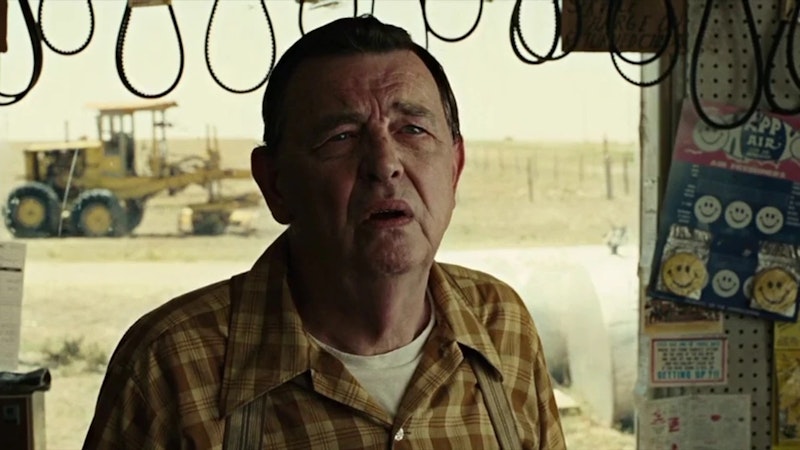Last fall, I wrote about the four Hollywood Westerns that all came out within weeks of each other in late-2007: There Will Be Blood, 3:10 to Yuma, The Assassination of Jesse James by the Coward Robert Ford, and No Country for Old Men. I saw just two of those when they came out—the first and last—and after looking at Andrew Dominik’s Jesse James and James Mangold’s 3:10 to Yuma, it’s easy to say that only the latter was a dog. The other three are great American films, rare enough back then and near impossible to find now. All five filmmakers are still alive and working, but the Coen Brothers have split up: Joel Coen made his solo debut two years ago with The Tragedy of Macbeth (bore), and Ethan Coen’s Drive Away Dolls was set for release last September before the SAG-AFTRA strike; it’s been rescheduled for the spring.
At the start of the 2000s, the Coens pioneered digital color correction in their film O Brother, Where Art Thou? Celluloid purists like Christopher Nolan and Quentin Tarantino didn’t have anything to worry about yet, but within a decade, digits supplanted film as a means of production and projection. The Coens, along with Steven Soderbergh and David Fincher, made movies look worse, catapulting an underdeveloped and soulless system into common use and destroying the infrastructure of photochemical film production across the world. They made everything yellow, sharp, and harsh.
Ava DuVernay was widely criticized on Monday after an interview with The New Yorker came out promoting her new film Origin; toward the end, she was asked if people watching her movies on their phones bothers her. “I’ll tell you that I care just as much about every frame of my film as Christopher Nolan cares about his… I care as much about every frame as he does, but I would sacrifice in a heartbeat all of the work that I put into the way the thing looks: every decision of every pillow, every flower, every move of the camera, my lighting, my sound—that Skywalker sound that I’ve worked on for three months!—the color grade… I would sacrifice it all for you to see the film, not get those aesthetic virtues, and hear what I’m trying to say rather than looking at the way that I’m saying it. Like, watching Selma on a plane. If I looked at it just for aesthetics, it would break my heart, because it’s washed out and it looks like crap. But then I see people smiling or crying or feeling or watching with their eyes glued to the back of that seat. What would you choose?”
The idea that a film’s aesthetics and whatever it’s trying to “say” are distinct is ridiculous: a film “talks” through its images, its sound, and its montage. A generous reading of this out-of-context quote suggests that DuVernay is happy that her films are seen at all, and that they still work on lousy formats. Any good filmmaker should feel this way. Great films are more than the sum of their parts, but they need those exact parts to be “more than.” Michael Mann’s Collateral, which DuVernay worked on 20 years ago, is a typical Los Angeles potboiler starring Jamie Foxx as the good guy and Tom Cruise as the bad guy. No more information can be extracted from the plot of Collateral that will separate it from thousands of crime paperbacks. The only reason Collateral works at all—emotionally, aesthetically, narratively—is through its images, its sound, and its montage.
What struck me most about No Country for Old Men—which was even more chilling and gripping 16 years later—was that there’s practically no score. What little music Carter Burwell recorded—all 16 minutes—is buried in the sound mix, and there’s a bit of acoustic guitar at the end of the end credits (an out of tune drop-D riff recalling Nirvana’s “Something in the Way”). Like all Coen Brothers movies after 2000, No Country for Old Men looks like shit: yellow, sharp, and punishing in a way that doesn’t serve the relentlessly grim film and only serves as a distraction; it’s the absence of music in the film that makes No Country so disturbing. Random, “senseless” violence is well-trodden territory in cinema, and to make something as conventional on paper into something this creepy doesn’t require a Christopher Nolan level attention to detail (the Coens are notorious for fast, economical shoots).
A movie is its aesthetics, but ultimately, DuVernay’s right: filmmakers want their movies to be seen and received by any means necessary. Aesthetics can’t be separated from narrative filmmaking any more than writing can lose the alphabet, but that person crying in their seat watching Selma, that is all you want, and all you should be after.
—Follow Nicky Otis Smith on Twitter and Instagram: @nickyotissmith

